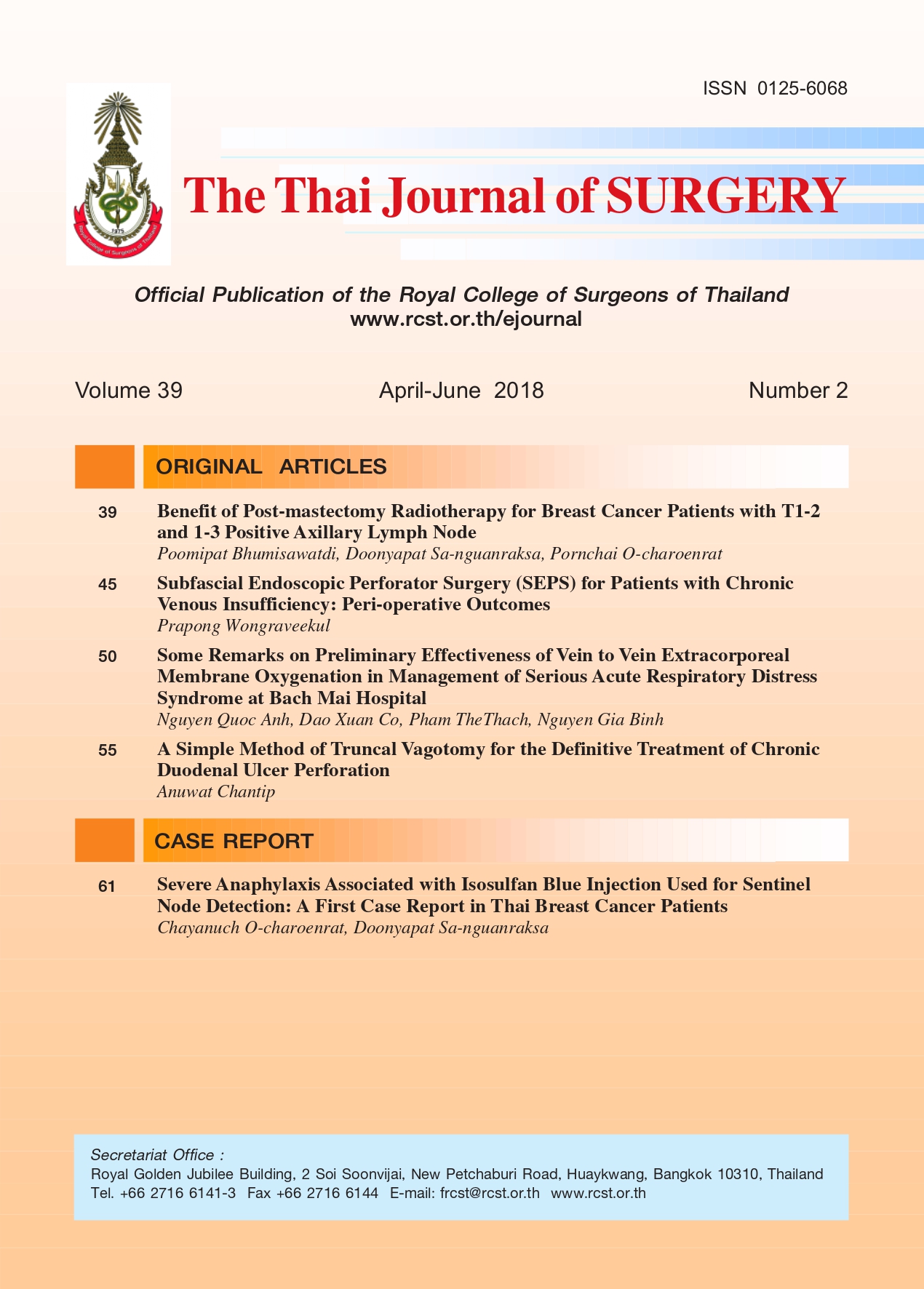Subfascial Endoscopic Perforator Surgery (SEPS) for Patients with Chronic Venous Insufficiency: Peri-operative Outcomes
Keywords:
Chronic venous insufficiency, lipodermatosclerosis, subfascial endoscopic perforator surgeryAbstract
Background: Chronic venous insufficiency (CVI) is an uncomfortable condition which may result in pain and ulceration, especially in patients who fail compressive therapy. In this situation Subfascial Endoscopic Perforator Surgery (SEPS) is a treatment option for general surgeons who are familiar with endoscopic surgery. The author practiced and examined the effectiveness of SEPS in this group of patients.
Methods: Patients diagnosed with CVI who failed to compressive therapy and underwent SEPS between April 2007 July 2017 were included in this study. Peri-operative outcomes were reviewed.
Results: Ten patients had complications of CVI. Six patients have active ulcers and four patients suffered pain and swelling of their legs from lipodermatosclerosis. After the SEPS operation pain was relieved in 2 weeks and the mean of time to ulcers healing was 34.17 days.
Conclusions: SEPS is an effective alternative treatment for patients with CVI who fail compressive therapy and have active ulcer or lipodermatosclerosis.
References
2. Linton RR. The operative treatment of varicose veins and ulcers, based upon a classification of these lesions. Ann Surg1938;107:582-93.
3. Cikrit DF, Nichols WK, Silver D. Surgical management of refractory venous stasis ulceration. J VascSurg 1988;7:473-8.
4. Cockett FB, Jones BD. The ankle blow-out syndrome: a new approach to the varicose ulcer problem. Lancet 1953;i:17-23.
5. Dodd H, Cockett FR, editors. The management of venous ulcers. In: pathology and surgery of the veins of the lower limbs. New York: Churchill-Livingstone; 1976. p. 269-96.
6. DePalma RG. Linton’s operation and modification of the open techniques. In: Gloviczki P, Bergan JJ, editors. Atlas of endoscopic perforator vein surgery. London: Springer-Verlag; 1998. p. 107-13.
7. DePalma RG. Surgical therapy for venous stasis: results of a modified Linton operation. Am J Surg 1979;137:810-13.
8. Edwards JM. Shearing operation for incompetent perforating veins. Br J Surg 1976;63:885-6.
9. Pierik EG, van Urk H, Hop WC, Wittens CH. Endoscopic versus open subfascial division of incompetent perforating veins in the treatment of venous leg ulceration: a randomized trial. J VascSurg 1997;26:1049-54.
10. Porter JM, Moneta GL. Reporting standards in venous disease: an update. International Consensus Committee on Chronic Venous Disease. J VascSurg 1995;21:635-45.
11. Tenbrook JA, Iafrati MD, O’Donnnell TF Jr, et al. Systemic review of outcomes after surgical management of venous disease incorporating subfascial endoscopic perforator surgery. J Vasc Surg 2004;39:583-9.
12. Padberg FT Jr, Pappas PJ, Araki CT, et al. Hemodynamic and clinical improvement after superficialvein ablation in primary combined venous insufficiency withulceration. J Vase Surg 1996;24:711-8.
13. Nelzén O, Fransson I. True long-term healing and recurrence of venous leg ulcers following SEPS combined with superficial venous surgery: a prospective study. Eur J Vasc Endovasc Surg 2007;34:605-12.
14. Gloviczki P, Bergan JJ, Menawat SS, et al. Safety, feasibility, and early efficacy of subfascial endoscopic perforator surgery: a preliminary report from the North American registry. J VascSurg 1997;25:94-105.
Downloads
Published
How to Cite
Issue
Section
License
Articles must be contributed solely to The Thai Journal of Surgery and when published become the property of the Royal College of Surgeons of Thailand. The Royal College of Surgeons of Thailand reserves copyright on all published materials and such materials may not be reproduced in any form without the written permission.


